The focus of the completed PhIR-10 research project was the development of thermopiles with wavelength-selective absorbers. The target application of these thermopiles is based in gas analysis and determining the concentration of various substances such as carbon dioxide and water in gas mixtures. To this end, ideas were implemented to produce layer systems and absorbers in such a way that a structuring process simultaneously produces thermopiles and absorbers that are particularly sensitive to different wavelengths.
First, optical simulations were used to select and optimize absorbers so that the absorption for a target wavelength that corresponds to the absorption band of a substance to be detected is as high as possible (ideally over 90%) and as low as possible for the remaining wavelengths. In addition, the direct integration of the absorbers on the membrane of the thermopile sensor was evaluated. These structures were then integrated into a layer on the thermopile and characterized.
Similar absorbers are conceivable not only for carbon dioxide and water, but also for a variety of other substances such as ethanol, acetone, nitrogen oxides and fluranes.
 The research and development work described was funded by the Federal Ministry of Economic Affairs and Climate Action (BMWK) in the research project “Gas detection based on absorbers integrated in thermopiles” (PhIR-10).
The research and development work described was funded by the Federal Ministry of Economic Affairs and Climate Action (BMWK) in the research project “Gas detection based on absorbers integrated in thermopiles” (PhIR-10).
Funding code: 49MF210027




